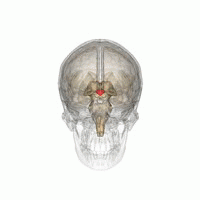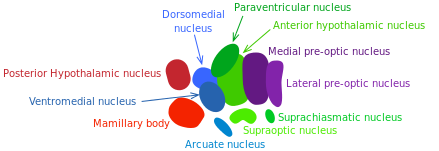The human system is an ecosystem of its own composed of numerous cells, all specialized with different structures and components aiming towards the existence of the whole being. The human body being composed of about 37.2 trillion cells device several ways of maintaining balance within the body, this is known as homeostasis. The word homeostasis was first used by an Harvard professor by the name Walter B. Cannon in the year 1960.

Source :: Licence: Public Domain
Homeostasis describes the maintenance of some parameters of the body such as blood sugar level, acidity, water-salt balance, body temperature, hormonal balance and electrolyte balance within a specific range. Exceeding or falling short of this range can lead to development of a sickness and possibly death. This maintenance is highly necessary as the metabolic activities responsible for live only occur within specific environments (balanced environment). Without homeostasis, the body's temperature, blood pressure, hunger, thirst and immunity will be out of control.

Source :: Licence: CC-BY-SA 2.1 :: Images are generated by Life Science Databases(LSDB)
All the functions carried out by the hypothalamus is made possible by some groups of neurons known as nuclei, or more specifically- hypothalamic nuclei (Singular: Nucleus). There are three groups of nuclei in the hypothalamus: the anterior or preoptic group, the middle or tuberal group of nuclei and the posterior or mammillary group of nuclei. The table below expands the individual hypothalamic nuclei and the group in which they are grouped.

Source :: Licence: Share alike 4.0 :: Author: oldblueday
| Anterior group | Middle group | Posterior group |
|---|---|---|
| Preoptic nucleus | Arcuate nucleus | Posterior nucleus |
| Supriachiasmatic nucleus | Lateral nucleus | Mamillary body |
| Supra optic nucleus | Dorsomedial nucleus | |
| Paraventricular nucleus | Ventromedial nucleus |
These nuclei have different afferent and efferent connections to other part of the brain. These connections or tracts are important to receive information and as well send signals to other part of the brain. A majority of these connections is established with the structures of the limbic system. This system is made of structures in the brain responsible for survival of a person as well as memory formation. For an organism to survive, it need s food, water, shelter. For an organism's species to survives, it needs procreation. All these are the functions of the limbic system which the hypothalamus contributes to.
The mammillary body located in the hypothalamus is concerned with alertness. It is also referred to as the wakefulness center. When this structure is stimulated, it leads to wakefulness, however, developing a fault in this region of the hypothalamus can lead to sleep. However, this structure is not solely responsible for wakefulness and sleep as other structures such as the anterior hypothalamus and brainstem role in alertness and arousal. The brainstem along with the hypothalamus causes alertness by stimulating the cerebral cortex which is responsible for movements (motor activities), sensation and reasoning; as long as arousal signals are being sent to this large structures of the brain, a person is kept awake. Read More...
Appetite and thirst are regulated by the hypothalamus. The motivation to eat comes majorly from lack of food when the hormone ghrelin is secreted by the body and detected by the hypothalamus (other factors include smell of food, memory about food, how food looks etc). Hence, the secretion of ghrelin is regulated by food consumption. Another name for the hormone ghrelin is "hunger hormone" because of its major role in hunger and appetite stimulation. Ghrelin also stimulate storage of energy inform of fat under the layer of skin and as well stimulate the secretion of Growth hormone. When this hormone is administered, it increases food consumption up to 30%. It is mainly secreted by the stomach, intestine brain and pancreas.
The exact opposite of this hormone ghrelin is leptin which is also referred to as satiety hormone. It inhibits hunger and make one feel satisfied. When the level of leptin decreases, it also induces hunger. When a person has excess fat in the body, the fat cells begin to secrete leptin in order to reduce food intake and unnecessary fat storage. A problem can arise whereby excess leptin is produced into the blood of an obese person by fat cells, soon the hypothalamus becomes resistant to this hormone (condition known as leptin resistance) which causes the person to continue eating and getting more obese and as well getting more and more increased level of leptin.
These two hormones, leptin and ghrelin are responsible for signalling the hypothalamus about the state of the body on food intake and energy level. The hypothalamus is made up of three major parts that roles in hunger and appetite: Lateral hypothalamus for recognition of hunger, ventromedial hypothalamus for recognizing fullness and paraventricular hypothalamus for regulating hunger. Food intake can be summed up to be regulated by two centers in the hypothalamus: feeding center and satiety center
The feeding center is is found in the lateral hypothalamic nucleus. Stimulating this nucleus in animal modeled experiment resulted in uncontrolled hunger and excessive food intake leading to obesity, however, a lesion or destruction of this nucleus can lead to permanent loss of appetite- this condition is known as anorexia
The satiety center is found in the ventromedial nucleus. This center causes satisfaction and cessation of food consumption. An animal will not eat even then losing energy when this center is stimulated. This explains why some sickness can lead to loss of appetite. In the same way, toxins released by microbes in the blood can reset the temperature center of the hypothalamus leading to a fever.
The temperature center comprises of two different center: the heat loss center and the heat gain center. The heat loss center is found in the preoptic nucleus of the anterior group and the heat gain center is present in the posterior group of hypothalamic nucleus.
The hypothalamus regulates water balance by two mechanisms. The thirst mechanism to make the person take water and the ADH mechanism that help regulate both low water and high volume of water in the body. The ADH (antidiuretic hormone) when secreted into the blood makes the kidney retain water in the body causing the production of a concentrated urine. In absence of this hormone, the body looses excess water causing the excretion of a diluted urine. Osmoreceptors in the hypothalamus are specialized structures for detecting the volume of water in the body. The receptors detect the volume of the compartment outside cells through the osmolarity exerted by the volume. When the volume of the extracellular compartment increases, the osmolarity decreases and when the volume increases, the osmolarity decreases. When the osmoreceptors get stimulated, usually when the volume of the extracellular compartment decreases by 1 to 2%, the thirst center located in the lateral hypothalamic nucleus is stimulated causing thirst. Simultaneously, the supraoptic hypothalamic nucleus is stimulated and ADH is secreted making the kidney to conserve water.
When the Volume of the extracellular compartment increases, the supraoptic nucleus is not stimulated, no ADH is present in blood and the kidney hence excrete more waterMore on how the body conserve water.
Further Reading:
Neurophysiology
Hypothalamus Satiation
Leptin: Satiety Hormone
Ghrelin: Hunger hormone
Do not forget to upvote , comment and follow, I'd really appreciate, Thank you!


Hello! I find your post valuable for the wafrica community! Thanks for the great post! We encourage and support quality contents and projects from the West African region.
Do you have a suggestion, concern or want to appear as a guest author on WAfrica, join our discord server and discuss with a member of our curation team.
Don't forget to join us every Sunday by 20:30GMT for our Sunday WAFRO party on our discord channel. Thank you.
Congratulations! This post has been upvoted from the communal account, @minnowsupport, by Damzxyno from the Minnow Support Project. It's a witness project run by aggroed, ausbitbank, teamsteem, someguy123, neoxian, followbtcnews, and netuoso. The goal is to help Steemit grow by supporting Minnows. Please find us at the Peace, Abundance, and Liberty Network (PALnet) Discord Channel. It's a completely public and open space to all members of the Steemit community who voluntarily choose to be there.
If you would like to delegate to the Minnow Support Project you can do so by clicking on the following links: 50SP, 100SP, 250SP, 500SP, 1000SP, 5000SP.
Be sure to leave at least 50SP undelegated on your account.